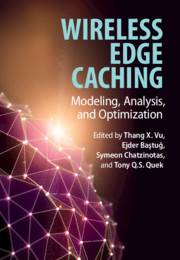Book contents
- Frontmatter
- Contents
- List of Contributors
- Preface
- 1 Introduction
- Part I Optimal Cache Placement and Delivery
- Part II Proactive Caching
- Part III Cache-Aided Interference and Physical Layer Management
- 11 Cache-Enabled Cloud Radio Access Networks
- 12 Fundamentals of Coded Caching for Interference Management
- 13 Full-Duplex Radios for Edge Caching
- 14 Caching in Mobile Millimeter Wave: Sub-6 GHz Networks
- Part IV Energy-Efficiency, Security, Economic, and Deployment
- Index
12 - Fundamentals of Coded Caching for Interference Management
from Part III - Cache-Aided Interference and Physical Layer Management
Published online by Cambridge University Press: 19 October 2020
- Frontmatter
- Contents
- List of Contributors
- Preface
- 1 Introduction
- Part I Optimal Cache Placement and Delivery
- Part II Proactive Caching
- Part III Cache-Aided Interference and Physical Layer Management
- 11 Cache-Enabled Cloud Radio Access Networks
- 12 Fundamentals of Coded Caching for Interference Management
- 13 Full-Duplex Radios for Edge Caching
- 14 Caching in Mobile Millimeter Wave: Sub-6 GHz Networks
- Part IV Energy-Efficiency, Security, Economic, and Deployment
- Index
Summary
This chapter investigates the impact of caching in the interference networks. First, we briefly review the basics of some classic interference networks and the corresponding interference management techniques. Then we review an interference network with caches equipped at all transmitters and receivers, termed as cache-aided interference network. The information-theoretic metric normalized delivery time (NDT) is introduced to characterize the system performance. The NDT in the cache-aided interference network is discussed for both single-antenna and multiple-antenna cases. It is shown that with different cache sizes, the network topology can be opportunistically changed to different classic interference networks, which leverages local caching gain, coded multicasting gain, and transmitter cooperation gain (via interference alignment and interference neutralization). Finally, the NDT results are extended to the partially connected interference network.
- Type
- Chapter
- Information
- Wireless Edge CachingModeling, Analysis, and Optimization, pp. 236 - 256Publisher: Cambridge University PressPrint publication year: 2021



